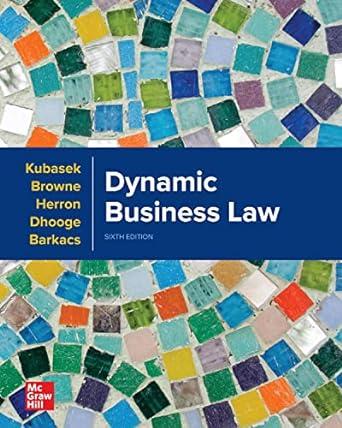Mr. Prestages foot and lower leg were caught in a combine manufactured by defendant SperryNew Holland. He
Question:
Mr. Prestage’s foot and lower leg were caught in a combine manufactured by defendant Sperry–New Holland. He and his wife sued Defendant for damages arising out of the accident. Their first cause of action was based on the theory of strict product liability. A jury awarded John \($1,425,000\) for his injuries and Pam \($218,750\) for loss of consortium (the ability to engage in sexual relations with one’s spouse). Defendant appealed.
JUDGE PRATHER … Two competing theories of strict liability in tort can be extrapolated from our case law. While our older decisions applied a “consumer expectations” analysis in products cases, recent decisions have turned on an analysis under “risk-utility.” We today apply a “risk-utility” analysis and write to clarify our reasons for the adoption for that test.
Section 402A is still the law in Mississippi. How this Court defines the phrases “defective conditions” and “unreasonably dangerous” used in 402A dictates whether a “consumer expectations” analysis or a “risk-utility” analysis will prevail. Problems have arisen because our past decisions have been unclear and have been misinterpreted in some instances.
“Consumer Expectations” Analysis … In a “consumer expectations” analysis, “ordinarily the phrase ‘defective condition’ means that the article has something wrong with it, that it did not function as expected.” Comment g of Section 402A defines “defective condition” as “a condition not contemplated by the ultimate consumer, which will be unreasonably dangerous to him.” Thus, in a “consumer expectations” analysis, for a plaintiff to recover, the defect in a product which causes his injuries must not be one which the plaintiff, as an ordinary consumer, would know to be unreasonably dangerous to him. In other words, if the plaintiff, applying the knowledge of an ordinary consumer, sees a danger and can appreciate that danger, then he cannot recover for any injury resulting from that appreciated danger.
“Risk-Utility” Analysis In a “risk-utility” analysis, a product is “unreasonably dangerous”if a reasonable person would conclude that the danger-fact, whether foreseeable or not, outweighs the utility of the product. Thus, even if a plaintiff appreciates the danger of a product, he can still recover for any injury resulting from the danger, provided that the utility of the product is outweighed by the danger that the product creates. Under the “risk-utility” test, either the judge or the jury can balance the utility and danger-in-fact, or risk, of the product.
Having here reiterated this Court’s adoption of a “risk-utility” analysis for product liability cases, we hold, necessarily, that the “patent danger” bar is no longer applicable in Mississippi. Under a “risk-utility” analysis, the “patent danger” rule does not apply. In “risk-utility,” the openness and obviousness of a product’s design is simply a factor to consider in determining whether a product is unreasonably dangerous.
There is sufficient evidence to show that Prestage tried his case under a “risk-utility” analysis. It is also clear from the record that the trial court understood “risk-utility” to be the law in Mississippi and applied that test correctly.
AFFIRMED in favor of plaintiff.
CRITICAL THINKING:
Why was the risk-utility test viewed as the best method of evaluating this case?
ETHICAL DECISION MAKING:
The risk-utility test allows products to pose a danger to consumers as long as they are reasonably safe. Under which ethical theory would producing such a product be ethical? Under which theory would such production not be ethical?
Step by Step Answer:

Dynamic Business Law
ISBN: 9781260733976
6th Edition
Authors: Nancy Kubasek, M. Neil Browne, Daniel Herron, Lucien Dhooge, Linda Barkacs





